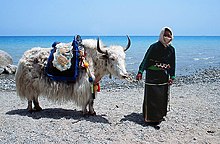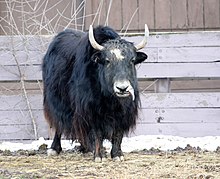Etymology
The English word "yak" derives from the Tibetan (Tibetan: གཡག་, Wylie: g.yag), or gyag – in Tibetan this refers only to the male of the species, the female being called a dri or nak. In English, as in most other languages which have borrowed the word, "yak" is usually used for both sexes.
Taxonomy
Yaks belong to the genus Bos, and are therefore closely related to cattle (Bos primigenius). Mitochondrial DNA analyses to determine the evolutionary history of yaks have been somewhat ambiguous. There is little differentiation between a Yak and the Highland Cattle. The yak may have diverged from cattle at any point between one and five million years ago, and there is some suggestion that it may be more closely related to bison than to the other members of its designated genus] Apparent close fossil relatives of the yak, such as Bos baikalensis, have been found in eastern Russia, suggesting a possible route by which yak-like ancestors of the modern American bison could have entered the Americas
The species was originally designated as Bos grunniens ("grunting ox") by Linnaeus in 1766, but this name is now generally only considered to refer to the domesticated form of the animal, with Bos mutus ("mute ox") being the preferred name for the wild species. Although some authors still consider the wild yak to be a subspecies, Bos grunniens mutus, the ICZN made an official ruling in 2003 permitting the use of the name Bos mutus for wild yaks, and this is now the more common usage.Except where the wild yak is considered as a subspecies of Bos grunniens, there are no recognised subspecies of yak.
[] Physical characteristics
Wild yaks are among the largest bovids, with adult
s standing about 1.6 to 2.2 m (5.2 to 7.2 ft) tall at the

shoulder and weighing 325–1,000 kg (720–2,200 lb) and having a head and body length of 2.5 to 3.4 m (8.2 to 11 ft). The tail is 70 to 100 cm (28 to 39 in) long in wild yaks. The females weigh about one third of this and are about 30% smaller in their linear dimensions. Domesticated yaks are much smaller, males weighing 350 to 580 kg (770 to 1,300 lb) and females 225 to 255 kg (500 to 560 lb)
Yaks are heavily built animals with a sturdy frame, short legs, and rounded hooves. They have small ears and a wide forehead, with smooth hollow horns that are generally dark in colour. In males, the horns sweep out from the sides of the head, and then curve forward; they typically range from 48 to 99 centimetres (19 to 39 in) in length. The horns of females are smaller, only 27 to 64 centimetres (11 to 25 in) in length, and have a more upright shape. Both sexes have a short neck with a pronounced hump over the shoulders, although this is larger and more visible in males]
Both sexes have long shaggy hair with a dense woolly undercoat over the chest, flanks, and thighs to insulate them from the cold. Especially in males, this may form a long "skirt" that almost reaches the ground. The tail is long, with a large plume of hair over much of its length. Wild yaks typically have black or dark brown hair over most of the body, with a greyish muzzle, although some wild golden-brown individuals have been reported. Domesticated yaks have a wider range of coat colours, with some individuals being white or piebald. The udder in females and the scrotum in males are small and hairy, as protection against the cold. Females have four teats.[]
Physiology
Yak physiology is well adapted to high altitudes, having larger lungs and heart than cattle found at lower altitudes, as well as greater capacity for transporting oxygen through their blood[] due to the persistence of foetal haemoglobin throughout life.[] Conversely, yaks do not thrive at lower altitudes,[] and begin to suffer from heat exhaustion above about 15 °C (59 °F). Further adaptations to the cold include a thick layer of subcutaneous fat, and an almost complete lack of functional sweat glands.
Compared with domestic cattle, the rumen of yaks is unusually large, relative to the omasum. This likely allows them to consume greater quantities of low-quality food at a time, and to ferment it longer so as to extract more nutrients]
[Odor
Yaks have some of the strongest odors of any domesticated animal, oftendescribed as a combination of cow manure and wet dog. Their thick coat of fur plays a strong role in this, as fecal and urinary odor often becomes "trapped" inside.[
[ Reproduction and life history

Yaks mate in the summer, typically between July and September, depending on the local environment. For the remainder of the year, many males wander in small bachelor groups away from the large herds, but, as the rut approaches, they become aggressive and regularly fight amongst each other to establish dominance. In addition to non-violent threat displays, bellowing, and scraping the ground with their horns, male yaks also compete more directly, repeatedly charging at each other with heads lowered or sparring with their horns. Like bison, but unlike cattle, males wallow in dry soil during the rut, often while scent-marking with urine or dung Females enter oestrus up to four times a year, and females are receptive only for a few hours in each cycle.[]
Gestation lasts between 257 and 270 days,[] so that the young are born between May and June, and results in the birth of a single calf. The female finds a secluded spot to give birth, but the calf is able to walk within about ten minutes of birth, and the pair soon rejoin the herd] Females of both the wild and domestic forms typically give birth only once every other year,although more frequent births are possible if the food supply is good.
Calves are weaned at one year and become independent shortly thereafter. Wild calves are initially brown in colour, and only later develop the darker adult hair. Females generally give birth for the first time at three or four years of age,and reach their peak reproductive fitness at around six years. Yaks may live for more than twenty years in domestication or captivity, although it is likely that this may be somewhat shorter in the wild.
[ Wild yaks

Wild yaks (Bos grunniens mutus or Bos mutus, Tibetan: འབྲོང་, Wylie: 'brong) usually form herds of between ten and thirty animals. They are insulated by dense, close, matted under-hair as well as their shaggy outer hair Yaks secrete a special sticky substance in their sweat which helps keep their under-hair matted and acts as extra insulation.[citation needed] This secretion is used in traditional Nepalese medicine.[citation needed] Many wild yaks are killed for food by hunters in China; they are now a vulnerable species
The diet of wild yaks consists largely of grasses and sedges, such as Carex, Stipa, and Kobresia. They also eat a smaller amount of herbs, winterfat shrubs, and mosses, and have even been reported to eat lichen. Historically, the main natural predator of the wild yak has been the Tibetan wolf, but brown bears and snow leopards have also been reported as predators in some areas
Thubten Jigme Norbu, the elder brother of Tenzin Gyatso, the 14th Dalai Lama, reported on his journey from Kumbum in Amdo to Lhasa in 1950:
PHOTOS!
You may notice Photomania looks different. We have upgraded our platform for a more modern feel!